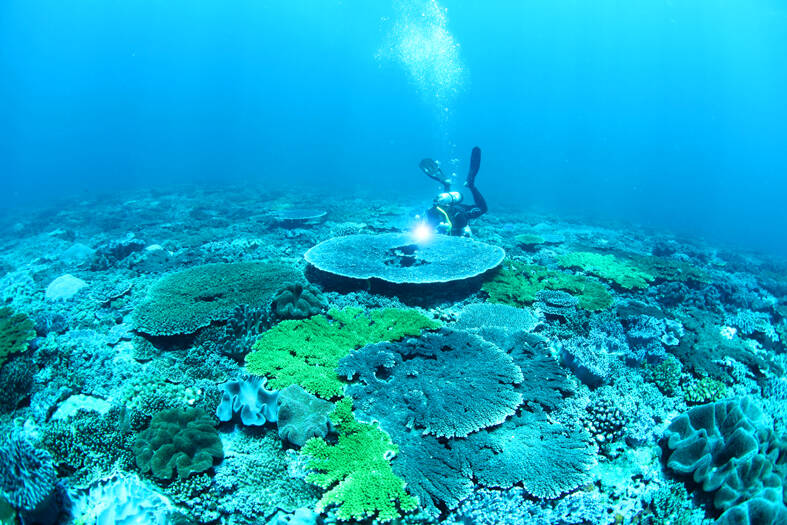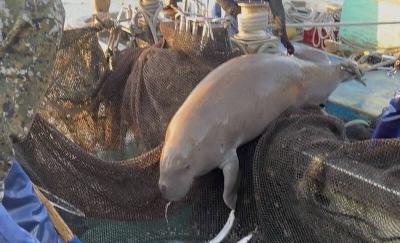The government should adopt a “leave no trace” principle for the Pratas Islands (Dongsha Islands, 東沙群島) if it develops tourism in the protected area, an academic said on Saturday.
The Dongsha Atoll National Park, at the southernmost tip of Taiwan’s territory, is the nation’s first marine national park, consisting of the Pratas Islands. It is nicknamed the “Pearl of the South China Sea.”
The government has in the past few years been rebuilding a port in the atoll at a depth of 4m, which is expected to be completed by the end of this year.

Photo courtesy of Jeng Ming-shiou
Amid growing enthusiasm for diving, the atoll has the potential to become a big tourist attraction for divers, Academia Sinica Biodiversity Research Center chief executive officer Jeng Ming-shiou (鄭明修) said.
To protect the marine environment and ecological systems, trips to the island must be operated on a “leave no trace” principle, following the example of tourism in Antarctica, in which tourists’ food and accommodation would be restricted to the vessel and their garbage would be shipped away, he said.
The national park features the largest seagrass bed among Taiwanese territorial waters, with nine seagrass species, and the Pratas Islands also boast valuable corals that once had a coverage of 60 to 90 percent of the atoll’s lagoon and outer waters, attracting more than 10,000 green sea turtles, Jeng said.
However, much of the coral that inhabited the 300km2 lagoon was bleached and died due to rising water temperatures from an El Nino event in 1998, while the corals surrounding the atoll have been threatened by crown-of-thorns starfish and illegal fishing by Chinese vessels, Jeng said.
Conservation efforts and the Coast Guard Administration’s efforts to clamp down on illegal fishing in the past few years have helped revive the marine environment around the atoll, he said.
While leading a research team to remove crown-of-thorns starfish last year, Jeng found the recovery is striking, adding that pods of dolphins have returned to the atoll, he said.
Divers saw 50 to 60 dolphins and other protected marine species, such as green humphead parrotfish and humphead wrasse, at least 70 of them each, he said.
The return of marine life to the area not only attests to Taiwan’s conservation efforts, but also demonstrates the atoll’s appeal to diving enthusiasts, he added.
When the national park was established in 2007, then-Kaohsiung mayor Frank Hsieh (謝長廷) permitted visits by tourists using a boat that could carry up to 200 passengers, Jeng said.
However, it did not take off, due to the lengthy sailing time and limited land and resources for sightseeing or entertainment, he said.
Diving was not as popular in Taiwan at the time, he said, adding that the trip from Kaohsiung to the island by boat requires about 20 hours, but circling the island by bike takes only 30 minutes.
The situation worsened as the port of the island silted up and could no longer berth vessels, he said.
Coast guard and national park personnel are stationed on the island, along with staff and researchers of the atoll’s international research station, who commute by airplane, Jeng said.

‘DENIAL DEFENSE’: The US would increase its military presence with uncrewed ships, and submarines, while boosting defense in the Indo-Pacific, a Pete Hegseth memo said The US is reorienting its military strategy to focus primarily on deterring a potential Chinese invasion of Taiwan, a memo signed by US Secretary of Defense Pete Hegseth showed. The memo also called on Taiwan to increase its defense spending. The document, known as the “Interim National Defense Strategic Guidance,” was distributed this month and detailed the national defense plans of US President Donald Trump’s administration, an article in the Washington Post said on Saturday. It outlines how the US can prepare for a potential war with China and defend itself from threats in the “near abroad,” including Greenland and the Panama

The High Prosecutors’ Office yesterday withdrew an appeal against the acquittal of a former bank manager 22 years after his death, marking Taiwan’s first instance of prosecutors rendering posthumous justice to a wrongfully convicted defendant. Chu Ching-en (諸慶恩) — formerly a manager at the Taipei branch of BNP Paribas — was in 1999 accused by Weng Mao-chung (翁茂鍾), then-president of Chia Her Industrial Co, of forging a request for a fixed deposit of US$10 million by I-Hwa Industrial Co, a subsidiary of Chia Her, which was used as collateral. Chu was ruled not guilty in the first trial, but was found guilty

A wild live dugong was found in Taiwan for the first time in 88 years, after it was accidentally caught by a fisher’s net on Tuesday in Yilan County’s Fenniaolin (粉鳥林). This is the first sighting of the species in Taiwan since 1937, having already been considered “extinct” in the country and considered as “vulnerable” by the International Union for Conservation of Nature. A fisher surnamed Chen (陳) went to Fenniaolin to collect the fish in his netting, but instead caught a 3m long, 500kg dugong. The fisher released the animal back into the wild, not realizing it was an endangered species at

DEADLOCK: As the commission is unable to forum a quorum to review license renewal applications, the channel operators are not at fault and can air past their license date The National Communications Commission (NCC) yesterday said that the Public Television Service (PTS) and 36 other television and radio broadcasters could continue airing, despite the commission’s inability to meet a quorum to review their license renewal applications. The licenses of PTS and the other channels are set to expire between this month and June. The National Communications Commission Organization Act (國家通訊傳播委員會組織法) stipulates that the commission must meet the mandated quorum of four to hold a valid meeting. The seven-member commission currently has only three commissioners. “We have informed the channel operators of the progress we have made in reviewing their license renewal applications, and